Slower car traffic and more eyes on the street will actually make Queensdale safer and more livable.
By Trey Shaughnessy
Published April 21, 2006
"They said the residences would become nothing more than row houses [emphasis added]".
-- Hamilton Mountain News, on Queensdale residents' concerns about a local infill project
Al Frisna, a long-time, respected Hamilton area developer and builder of the 43-storey Landmark Place, is proposing a well suited infill project near Upper Wellington and Queensdale. Area residents took a very typical NIMBY stance and opposed it based on fears of increased traffic, parking problems, and the horror of row houses incorporated into their neighbourhood fabric.
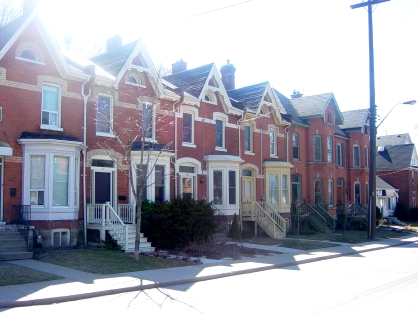
Row houses in downtown Hamilton (RTH file photo)
This attitude came as a shock to me. I know the area well. It is a war-era, working-class neighbourhood built on a grid of streets that some call the East Somethings, referring to the street numbering that starts at Upper James (zero) and incrementally numbers each street. Every tenth street is a main thoroughfare.
Upper Wellington would be East 10th Street if it was kept to the numbering sequence. Upper Wentworth would be East 20th, and so on to Upper Gage, which would be East 40th.
The homes are modest cottages and one and half storey middle working class houses. Some streets still have the back alley service laneways - very cool. The area was popular with steelworkers who found paradise on the Mountain in an ideal suburban setting to raise a family, with only a short commute to the factories down Kenilworth Access.

Row Houses in Auburn, Cincinnati (Photo Credit: Mount Auburn Presbyterian Church)
The Access is now too big for the substantially fewer number of workers traveling to the lower city. Consequently, terrible accidents occur due to speeding encouraged by the near-empty, wide freeway traversing Hamilton's eastern escarpment.
Today, the neighbourhood is home to a large portion of first generation immigrants and the retired original working class residents. The evidence is found at an old Roman Catholic Church with newer signs that read in an Asian language.
When I read the residents' concerns in the April 14 issue of the Hamilton Mountain News, I was shocked to hear such snobbery come from down-to-earth people.
These were my roots, my stomping grounds, and I had a sense of pride in the knowledge that I came from a pretense-free, tolerant, accepting, "Coronation Street" neighbourhood. We were the people who said "underwears," "no kidink," and "westren". That kind of attitude was something expected from the West Mountain, the "Knotting Hill" snobs.
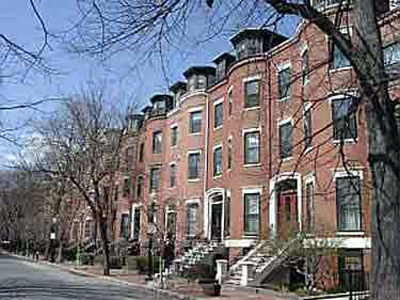
Row Houses in South End, Boston (Photo Credit: Emerson College School of Journalism)
Frisna's plan of seven single-family and 20 row homes will not cause congestion problems. The area has less traffic than it did 50 years ago, and the streets are completely capable of handling the small increase. There is on-street parking, sidewalks on both sides, and a small commercial strip only a short walk away.
The shopkeepers will be happy with an increase in customers. It will help to keep the local businesses in business and the nearby convenience of these stores should be seen as a benefit, especially to the older residents.
The plan is also in line with the Greenbelt legislation. The Province has called upon cities to intensify their urban neighbourhoods. Extra density and people will make the area more livable. After all, the alternative is a hollowed-out, boarded-up, vacated neighbourhood that becomes home to squatters.
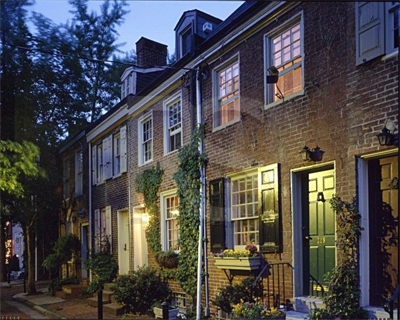
Row Houses in Philadelphia (Photo Credit: Ron Saari)
The fact that builders and people are still interested in the area should be regarded as a benefit. The property values will be maintained and even increased with this proposal. Queensdale is also on a bus route. The increase in residents ensures that is has a viable public transit route, also a big benefit to senior residents. Quite possibly, it is why Frisna chose this site for investment.
The neighbourhood will also become safer. More residents on the sidewalks, on their porches, and living in the area will put more eyes on the street, providing more leisurely strolls and making it safer to walk, cycle and live in.
The residents' traffic concerns are backwards. It is the empty, wide-open streets that have the serious accidents. On-street parking, and having to watch out for fellow traffic in narrow lanes, forces drivers to be more aware and drive with more caution.
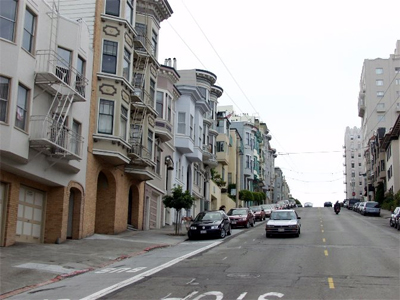
Row Houses in San Francisco (Photo Credit: Stewarts.us)
Highway strips like Queenston/Highway 8 in Stoney Creek are the roads that need extra caution. It is those types of open, wide streets that are often the scene of fatalities, due to speeding and drivers not paying attention because one doesn't expect to encounter a cyclist or pedestrian.
The residents of Queensdale have surprised me with their attitude. They should feel proud that a developer saw value and a future in their neighbourhood. The area hasn't exactly been the centre for investment for the last few decades.
I'm actually pleasantly surprised by Al Frisna's proposal. It comes at a time when many of his colleagues are building car-dependent sprawl on the edge of the city. Al Frisna obviously saw the future is in walkable, mixed-use areas serviced by public transit, schools, shops, churches, parks and most importantly, real neighbourhoods.
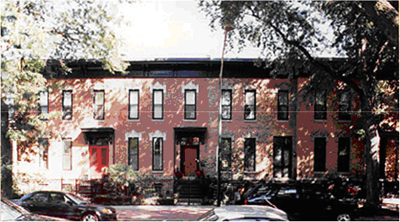
Row houses in Chicago (Photo Credit: Chicago Landmarks)
By A Robot (anonymous) | Posted April 23, 2006 at 02:42:09
While I certainly agree that intensification should be a welcome addition to any neighbourhood, the type of development described in the article is a far cry from the classic street-lining row house. With a private road leading in to the development and two parking spaces per unit, it sounds like just another boring chunk of suburban semis.
By KS (anonymous) | Posted April 26, 2006 at 16:05:21
As a nearby resident I attended the public information meeting where some of my neighbours expressed their fears of density. You are correct to describe their response as rampant NIMBYism, but you've missed some subtleties, which I think are interesting when evaluating such events.
First, no row housing. The Frisina brothers presented a plan for a combination of detached, single homes facing East 8th St. and a short, private road of semi-detached dwellings, with a minimum estimated value of $200,000 each. That's more than I'd get for my place built half a block away in the 1920s. Hardly high-density stuff. Most of those expressing fears of density were older than I am, which means they moved into the area with children who have since grown and left the area. It would take more than a small apartment building to raise this neighbourhood's density to levels that existed when these conscientious objectors first took on their mortgages.
Second, you're a bit off on your demographics. True, many of the homes between Inverness and Fennell, Upper Wellington and Upper James, are solid, working-class fare, and much of it pre- and immediately post-war, but the objections to the new homes came largely from owners of newer dwellings in the blocks just north of Bruce Park. This area was initially a survey of small, temporary, post-war cottages, quickly built to accommodate returning, family-minded troops. Some of these houses, raised over basements and with additions and dormers, still exist in surrounding streets. In the sixties whole blocks of these homes were shifted to the area of Upper Wentworth and Mohawk Rd. E. to be used as subsidized housing (again, temporarily, though it took roughly twenty years to knock them down for row housing.) The vacated land was developed with then fashionable, detached, ranch-style bungalos and side-splits on spacious lots. Apparently some who purchased these homes were promised in the sixties that no homes would be built in the surrounding neighbourhood unlike their own. And they believed it. So they did not much object to the detached dwellings intended to face East 8th, but the semis apparently are an unanticipated horror, despite the fact that there is a survey of townhomes along Brucedale Ave. by Upper James that seems to have blended into the community quite well.
Third, Queensdale between Uppers Wellington and James is not a bus route unless there's construction or some other impediment along Inverness. The area is well served by three routes, Upper James, which runs along Inverness, Upper Ottawa, which runs up Wellington to Queensdale before turning east, and Upper Wellington, which, well, runs up Upper Wellington. Oh, and Fennell, running east and west to the south of the community. With this, the aforementioned park and the public and separate schools both in this area, it's been an ideal area to raise a family. Sometimes, though, through traffic along Brucedale and Queensdale makes things a touch testy.
You can imagine my surprise when neighbours described the terror with which they approached the intersection of Queensdale and Upper Wellington. Queensdale jogs at this corner, making a left turn somewhat awkward. Some don't know whether to signal left/right for a straight down Queensdale, some just don't know what to do. Generally people proceed cautiously, and figure it out as they go. I can't remember an accident at that corner in the almost thirty years I've lived nearby. Then again, I might have missed one or two, but when I heard that some folks hadn't been able to solve the intersection in their nearly forty years of residence, and that they anticipated another thirty homes will plunge the intersection into chaos, I knew it was time to leave the meeting, before I got on a rant about the driving skills of seniors.
On further perception I'd like to address, however, is the notion that his area is suburban. The idea is supported by the escarpment, and separation into an upper and lower city, which fuelled some residents' objections to infilling. Even when I was a kid, living further south than I do now, and almost at the then city limits at Mohawk Road, I could walk down the James St. steps quite comfortably for weekly swimming lessons. Now, any one of those three bus routes I mentioned will get me to King and James, or the GO station and on a bus to TO, within ten minutes. With the city now stretching from Cambridge to Grimsby to Caledonia, I figure I'm pretty much in the thick of things. People in the so-called "suburb" of the central mountain can't continue kicking the lower city and imagine we're not bruising ourselves.
I know I'm downtown, looking forward to meeting my new neighbours, and walking to the even wider range of businesses and services they will help to support nearby.
You must be logged in to comment.
There are no upcoming events right now.
Why not post one?